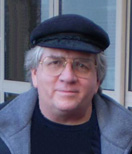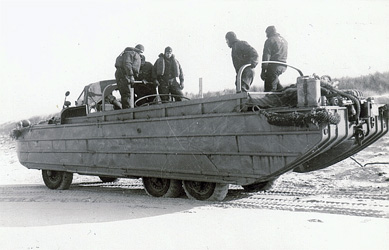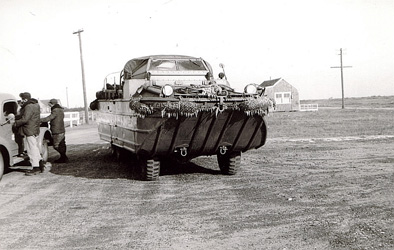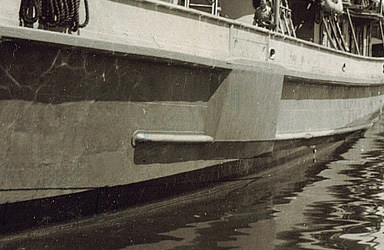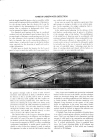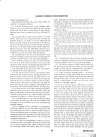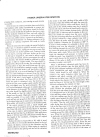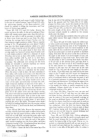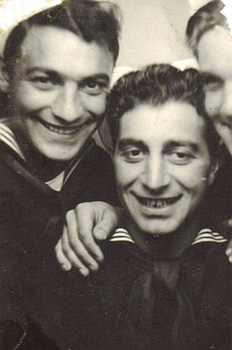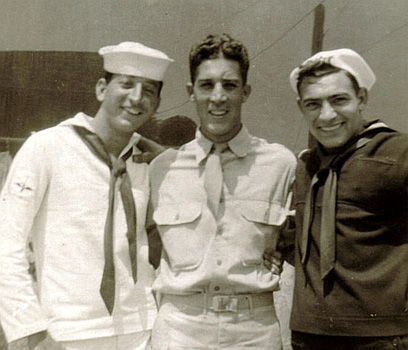
 |
USCG CABLE SHIP PEQUOT
|
 |
These pages tell the story of the U.S. Coast Guard Cable ship Pequot during World War II as a harbor defense cable-laying and repair ship under direction of the US Navy. This site presents details of the ship's Top Secret mission of laying anti-submarine indicator loop cables and the history of the ship during the Battle of the Atlantic. Extensive photos and text have been provided by the sailors who served on the Pequot and their families, and many of their personal stories are included. Also available are pages from the Harbor Defense Manual describing the duties of the Pequot. There are links to indicator loop technical pages, the construction of the ship in 1909, and to the personal story of the Pequot's Captain.
FEEDBACK
If you can help us identify any of the Pequot
sailors on this website please contact Chip Calamaio.
|
If you any feedback about indicator loops please email: Dr Richard Walding, Research Fellow - School of Science, Griffith University, Brisbane, Australia. Email: waldingr49@yahoo.com.au If you have comments or queries specifically about the Pequot, please contact Chip Calamaio chipaz@cox.net Phoenix, Arizona, USA. (H) 602-279-4505.
|
|
LINKS TO RELATED PAGES
United States Navy Loop Receiving Stations
 |
Museum Display |
About this Website |
 |
MAIN TOPIC SECTIONS (Click to Jump There)
| The Ship | The Mission | The Crew | War Years | Related Ships | Research Project |
| Construction | Mission | Crew Stories | Semper Paratus | The 1st USCG Pequot | About |
| Deck Plans | Manual | The Captain | Home Port | Sister Ships | Museum Display |
| 20mm | Cable Laying | Gunner's Mate | Women | Replacement | Radio Interview |
| Communications | DUKWs | The Bad Pie | Boston Harbor | Escorts | Models, artwork & animation |
| Radio Wars | Pequot's Loops in Action | A Weekend at York Beach | Storms | CG Auxiliary including CG94001 | Bibliography |
| Navigation | Nahant Loops - A Case Study | Victory | German Weather Ship | 83 Footers | |
| Magnetic Deviation | Other Duties | Crew List | Subchasers | ||
| Degaussing | 1920s & 30s | Subchaser 1296 | |||
| Decommissioning | How to read a loop signature | Other Pequots |
What's new?
Farewell Lee Coppo
 |
The Pequot research project has learned that Lee Coppo, wife of Pequot Boatswain's Mate Martin Coppo, passed away on Christmas Day 2023 at the age of 103. Lee was the last living connection we had to the Pequot crew from the 1940s.
|
 |
 |
With husband Martin in 1944 and 1988, and with daughter Carol and grandchildren
Erica and Aaron on her 90th birthday.
Lee was one of the first family members we located when the Pequot research project started in 2009. Over the past 15 years she remained our biggest fan. During World War II Lee worked as a teletype operator at the huge Willow Run B-24 Liberator bomber plant in Michigan.
 |
 |
Using a machine like this Lee sent coded messages all over the world
as part of aircraft production and deployment operations.
We honor Lee’s service to America during the war years and send our heartfelt condolences to her family.
Martin and Lee Coppo's Crew story is here: http://indicatorloops.com/usn_pequot_coppo.htm
Lee is also featured on our Women of the Pequot page at: http://indicatorloops.com/usn_pequot_women.htm
A Museum Quality Model of The General Samuel M. Mills
 |
Model builder Svein-Erik Eriksen of Sola, Norway has completed his large-scale model of the US Army Mine Planter the General Samuel M. Mills using the original 1908 construction drawings provided on this website. CLICK HERE for a detailed look at this amazing reproduction of the ship that became the Coast Guard Cable Ship Pequot. |
 |
| 2. From the Union Jack on the bow to Old Glory flying on the stern, Svein’s model is wonderful tribute to the Army Mine Planter that became the Coast Guard cable ship Pequot (comparison view, below). |
 |
Stephen Vozar
 |
| In November of 2022 we were contacted by Mike Vozar who sent us this photo of his father Motor Machinist Stephan Vozar Jr. who served aboard the Pequot in the 1930s. Thanks Mike! |
Million Dollar Pier
When a mysterious 100-year old photo album showed up at auction we learned about some Pequot sailors who tied up at a Million Dollar Pier in their Crackerjacks and played Hoover Ball. And we got a rare glimpse of the Pequot from the 1920s in one of earliest photos of the ship as a cable layer we've ever seen!
 |
 |
 |
 |
Farewell Mike Luongo
The Pequot research project has learned that Seaman 1st Class Mike Luongo passed away on March 30th 2018 at the age of 95.
 |
 |
Mike in the 1940s during his time aboard the Pequot |
Mike, at Oak Island, North Carolina in 2011 |
Mike was a driving force in helping us first create this website almost 10 years ago. He donated all of his WWII era photos and spent many hours helping identify the officers and men in other photos we were able to locate. We interviewed Mike at length about his years on the Pequot and his Coast Guard service. His recollections, stories, and details of day-to-day life during WWII greatly added to the authenticity of our Pequot story and provided an invaluable oral history record. You will find information from Mike throughout many of our webpages and his bio-sketch here: http://indicatorloops.com/usn_pequot_luongo.htm
We were honored to have known him and send our heartfelt condolences to his family. When we asked Mike what his favorite memory was of his time aboard the Pequot and his Coast Guard service during World War II, he told us:
| On Labor Day weekend 1945 we were bringing the Pequot up to New York. When we came in I ended up on the helm in the wheelhouse and could start to see the New York skyline. I was told to put the bow right on the Statue of Liberty. That was the biggest thrill of my World War II years, being on the wheel and steering the Pequot into New York - straight at the Statue of Liberty. |
 |
Rest in Peace, Sailor ... |
Presentation of Pequot model
Researcher Chip Calamaio was honored with the presentation of a wonderful model of the Pequot built by "Captain Bob" Thommen using the original drawings and photographs he obtained from this website. Bob Thommen recently passed away and it was his wish that Chip be given his model. "Although we never met," Chip tells us, "I worked with Bob since 2015 getting him details on the ship, additional photographs, and our 1908 construction drawings. I am amazed at the fine attention to detail in the model and will treasure it always!"
The August 1st 2017 presentation by the Thommen family in Prescott, Arizona was at the Yavapai Scale Modelers Club meeting.
 |
 |
Chip Calamaio with the Pequot model |
Yavapai Scale Modelers Club President Al Weiss (on the left) and on behalf of the Thommen family, Bob's brother-in-law Al Petroff (on the right). |
 |
 |
Pequot model |
Digital rendering of the Pequot by 3D modeler and texture artist Edoardo Siano. |
For additional photos of the model and to see beautiful high-quality digital renderings of the Pequot by 3D modeler and texture artist Edoardo Siano visit our new "Models, Artwork and Animation" page.
The Pequot's Contribution is Recorded in History
Author and historian Gerald W. Butler's latest book, "Nahant's Naval Secrets" chronicles the colorful history of military activities on and around the Nahant Peninsula of Massachusetts from World War I until the post World War II era. Jerry's painstakingly researched and illustrated work tells the story of the how indicator loops were installed by the Pequot from the tip of the Nahant Peninsula to form the Northernmost defensive perimeter around Boston Harbor. Those loops were a key component of the extensive defenses put in place to protect the vital WWII naval and shipping operations out of Boston throughout the war years. In researching this book Jerry collaborated with the Pequot website and included numerous photographs of the ship during cable laying operations. The text includes personal recollections of Pequot veterans and details on the methodical process involved by the Pequot's officers and men to properly lay down indicator loops. To obtain a copy of this 195 page book from the Nahant Historical Society just click here or on the thumbnail of the cover below.
Click centre image to visit Nahant Historical Society bookshop.
AWARDS
Some of the awards this website has been given:
 |
 |
 |
 |
|
Coast Guard Sea Veterans of
America Award |
Click image to view certificate. |
Yankee Station Award Yankee Station Website Award #64 |
Golden Griffin Award Griffin Website |
The Patriot Award. Patriot Website |
The Army Mine Planter General Samuel M. Mills becomes the US Coast Guard Cable Ship Pequot
 |
4. The General Samuel M. Mills - later the USCG Pequot - during sea trials in 1909. (Independence Seaport Museum Archives) |
In April 1922, the Army minelayer General Samuel M. Mills was decommissioned and acquired by the Coast Guard
- and renamed as The Pequot. The General Samuel M Mills, was constructed
for $300,000 in 1908 at the New York Shipbuilding Company in Camden, New Jersey under a
contract with the Submarine Mine Service of the US Coast Artillery Corps which
was under the War Department, US Army, Office of the Quartermaster General. The
ship was named after Brigadier General Samuel Meyers Mills, Jr. who was the U.S.
Army's Chief of Artillery 1905-1906 (see photo below). She was
converted to a cable laying ship by the American Brown Boveri Electrical
Corporation of Camden, New Jersey and renamed Pequot (WARC-58).
The fact that an "electrical" company did the conversion indicates the addition
of the motorized winches and other specialty equipment required to modify the
ship to conduct general cable laying and repair work.
|
|
 |
5. The General Samuel M. Mills (March 11, 1927) - later the Pequot. Note the absence of the cable wheel on the bow of the ship. (Photo supplied Jim Flynn) |
6. A later photo of the Pequot shows
the cable wheel on the bow. Called a "sheave" this pulley was used when laying
and salvaging cable. |
7.
1st Lt Samuel M. Mills, Jr in 1877 with the Department of Tactics. |
Now renamed as The Pequot, the former mine planter Mills was commissioned as a US Coast Guard cable ship and special craft on April 29th 1922. She replaced an earlier Coast Guard cable ship also named Pequot. Beginning on March 4th 1923 the new Pequot (ex-Mills) was assigned to the Coast Guard's New York District Office and operated out of New London, Connecticut. On March 27th 1929 she was transferred to the Norfolk, Virginia Coast Guard Depot and was stationed at the port at Norfolk until June 15th 1932 when the ship was assigned to the Boston, Massachusetts Coast Guard Office. The Pequot was temporarily assigned to the Commander-In-Chief of the Atlantic Fleet on August 5th 1941 then shortly before the attack on Pearl Harbor, on November 1st 1941, she was officially transferred from the Coast Guard to the Navy and assigned as a cable laying and repair ship out of New London, Connecticut. From her home port of Boston she was responsible for laying and repairing indicator loop and communications cables for the remainder of World War II.
|
|
8. Flag from the US Mine Planter General Samuel M. Mills. In 1909 the term "Submarine" on the flag meant "underwater" defense as in sea mines and not the anti U-boat submarine defense which came decades later. |
9. A close-up of the note written on the flag (A Place Called Yorkship / yorkship.us) |
For a detailed look at the design plans, cabin details, and construction photos of the General Samuel M. Mills 1908-09 click here
 |
The original construction drawings reveal how the ship's crew and
the Army troops involved in mine laying operations were provided with
completely separate quarters, galleys, and bathrooms.
It is also clear that accommodations for the ship's officers were
much nicer than the quarters for sailors and soldiers when the Mills first put to sea in 1909. Click image to enlarge. |
Part Two of our ship
construction section presents information on five of the Pequot's Sister
Ships.
To learn about their history and see them under construction, click here
 |
 |
 |
| Mills II - keel laying. (Joyner Library, ECU) |
(Independence Seaport Museum Archives) | |
THE TOP SECRET WWII MISSION - INSTALLING ANTI-SUBMARINE INDICATOR LOOPS
Anti-submarine Indicator
Loops
Indicator Loops - an overview (YouTube, 70 minutes)
Indicator Loops are long lengths of armoured cable laid on the seafloor of harbors to detect enemy submarines. They were developed by the Royal Navy in the early 1900s and first trialled at the end of WW1. They were successfully deployed in WW2 in British ports and other Commonwealth countries such as Australia, Canada, New Zealand, South Africa, Kenya, Ceylon, Penang, and in allied harbours (Iceland, Holland, Dardanelles). By 1942 the United States had adapted this technology for its own needs and a dozen United States Navy "loop receiving stations" were established along the eastern seaboard of mainland USA particularly at the ports of Boston and Portland. The Pequot was the main cablelayer for the USN's indicator loop harbor defense. The deployment of indicator loops was highly secret and hardly any of the men knew the purpose of the cables; most thought they were underwater communications cables. The words indicator loop were not used - just cable. |
 |
| 10. This diagram shows the arrangement of the cables in the loop ("3-legged") and the tail cable connecting them to the shore station. The Pequot crew laid the loop cable in the correct position and joined it to the tail cable using waterproof splices and junction boxes. | Sample of indicator loop paper recording chart from the inbound crossing of a loop at Portland Maine on July 14th 1942 by USS Massachusetts. Click the image above to see more examples of the Pequot's Indicator Loops in Action. |
 |
 |
| 11. Longitudinal drawing of indicator loop cable recovered from Mediterranean waters. It has a diameter of 30 mm (1¼") and the section labeled "6" is the lead wire. The steel armor wires (#10) also has a lead coating. After the war this type of valuable lead loaded cable was pulled back up and salvaged by the Pequot and other ships. To date no sample of harbor defense loop cable from the US has been located, although many miles of tail cable has been found. A full description of this cable can be found on the Cablemakers webpage. | 12. Cross section of indicator loop cable to the left. |
NAHANT'S NAVAL SECRETS - A PEQUOT CASE STUDY
The August 2012 Coast Defense Journal published by the Coast Defense Study Group features a detailed article by author and historian Gerald W. Butler on the indicator loop defenses installed by the Pequot at Nahant, Massachusetts in 1942 as part of the comprehensive installations put in place to protect Boston Harbor.
 |
 |
 |
The 30-page article by Gerry Butler on Nahant's Loop Station was published in the August 2012 issue of Coast Defence Journal |
||
"Naval Unit 1D - East Point, Nahant, Massachusetts, in World War II, 1942-1945" provides an excellent case study on one of the indicator loop defense systems laid down by the Pequot and details the history of this top secret underwater detection installation from the initial planning stages through the end of the war when the indicator loop station was closed in May of 1945. Click here to go to our webpage about Gerry Butler which includes a copy of his 30-page article from the Coast Defense Journal.
USCG Pequot - Mission Accomplished and a Job Well Done
Beginning less than four months after the attack on Pearl Harbor the Pequot joined the intense efforts of the Army, Navy, and civilian agencies to get a viable harbor defense system installed and operational. This was during the period when U-boat attacks where at their peak and the overall situation along the entire Atlantic seaboard was very grim. The Pequot and its crew responded and played a vital role in establishing the initial indicator loop defenses at entrances to major US ports. Her outstanding efforts did not go unnoticed. On March 24th 1942 the Chief of Naval Operations provided the following formal Commendation to The Commandant of the US Coast Guard and the Pequot's Commanding Officer:
|
During the past ten months the Pequot has laid over fifty miles of armored cable for
establishing magnetic indicator loop systems in four widely
separated areas of the Atlantic Coast. This special work has
been accomplished in addition to many varied demands for her
normal service and has been done often under the most
adverse conditions of weather. It is considered that the
Commanding Officer of the Pequot, her other officers,
and her crew deserve special commendation for their manifest
efficiency in performance of duty. |
In addition to this major push at the outbreak of hostilities, the Pequot would continue to install indicator loop cables at ports and harbors along the Atlantic coast as far North as Argentia, Newfoundland, as well as service and repair damaged cables throughout the war. When not working on indicator loop cables, the Pequot was kept very busy laying and servicing coastal communication and teletype cables along the Atlantic seaboard between Coast Guard lifesaving stations and lighthouses. She also pulled up and salvaged cable no longer in use and ran electrical power cable to isolated light stations. A sailing list of officers and men is at the end of this webpage. Also included is a section from the USN Harbor Defense Manual dealing with laying and repair of indicator loops.
 |
 |
13. USCG Pequot fully underway in the North Atlantic - circa 1940 (Courtesy the John McCormack family) |
14. The USCG Pequot tied up along Constitution Wharf at her Boston Coast Guard Base home berth, circa 1945. Here we can clearly see the wear and tear on her bow and hull from hard years at sea during World War II. (Lou Carhart). Click to enlarge. |
Decommissioning of the Pequot
Just before the end of hostilities, the Pequot was reassigned to Norfolk, Virginia and she officially was returned to the Coast Guard on January 1st 1946. According to her ship movement logs the Pequot's last duty assignments during 1946-47 involved cable work off of Cape Henry, Virginia and while operating out of Little Creek and Norfolk, Virginia and Portsmouth, New Hampshire her crew salvaged many miles of undersea cable which was re-used for telephone and telegraph purposes. At one point in June of 1946 she was laid up in Portsmouth and unable to go to sea due to a "personnel shortage." So after many of her Reservist sailors were discharged after the war it appears she was operating with a much smaller crew.
The ship's last cruise under her own power took her from Philadelphia to New York, through Long Island Sound and then to St George, New York on the tip of Staten Island, then she steamed through the Cape Cod Canal to Boston where she arrived on September 13th 1946.
The US Coast Guard cable ship Pequot was decommissioned on November 8th 1946 at her historic WWII home berth of Constitution Wharf in Boston, Massachusetts. Three months later on February 12th 1947 she was towed by the US Coast Guard Cutter Cherokee to joint the "nest" of other decommissioned Navy and Coast Guard ships of the Atlantic Reserve Fleet berthed on the Wando River near the Naval Base at Charleston, South Carolina.
 |
 |
| The US Coast Guard Cutter Cherokee (AT-66) was the Navajo Class ocean going tug that towed the decommissioned Pequot from Boston to the Atlantic Reserve Fleet storage site on the Wando River. (USCG photo) | Decommissioned ships of the Atlantic Reserve Fleet on the Wando River in South Carolina 1946. The Pequot joined this "Ghost Fleet" until she was sold for scrap in 1947. (NavSource Naval History Collection) |
After more than 35 years at sea serving the Army, Coast Guard, and Navy she was sold for scrap by the US Maritime Commission on September 5th 1947 to Potomac Shipwrecking Company, Inc. of Popes Creek, Maryland and delivered the same day.
The Pequot's Replacement
As early as 1944, based upon engineering reports of the Pequot's deteriorating mechanical condition, the Coast Guard started looking around for a replacement ship. The US Navy's Walnut (YN-31) was considered but she was stationed in Honolulu and would require a long transfer. Based upon recommendations from the Pequot's Captain Lars Sande, and the office of Coast Guard Admiral Park, "that an Army Mine Planter would be suited seems to have considerable merit." But the decision on a good replacement for Pequot didn't happen until after the war when in June of 1946 the Navy's Chimo Class mine layer, Trapper (ACM-9), was obtained by the Coast Guard, converted for cable work, and renamed the Yamacraw (WARC-333). She was originally built to plant and tend controlled defensive minefields for the Army's Coast Artillery Corps. While the Pequot was with the Atlantic Reserve Fleet she was taken from the Wando River storage site to the Charleston Naval Shipyard where her forward cable engine and winch were removed and installed on the Yamacraw.
After more than 10 years of Coast Guard service she was returned to the Navy in 1959 who operated her as the cable repair and research ship Yamacraw (ARC-5) until she was decommissioned in July 1965 and sold for scrap in 1969.
 |
 |
 |
| 15. The USS Trapper (ACM-9) in 1945. The raised 40mm gun position on the
foredeck superstructure, the two 20mm gun positions above
the bridge, and the side and fantail mounted 20mm gun tubs,
were all removed during conversion to a cable ship. (National Archives photo 19-N-79421) |
16. The Pequot's
replacement USCG Yamacraw (WARC-333). Notice the cable
wheels now built into the ship's bow. (Naval Historical Center) |
17. By 1964 Yamacraw's bow had three large cable pulley sheaves. (Photo Victor G. Edens) |
 |
The 1st USCG Cable Ship PequotClick the Image To The Left to learn about the 1st US Coast Guard cable ship named The Pequot in 1919.
|
The Other PequotsClick the Image To The Right to see the colorful history of other United States ships named The Pequot
|
 |
Semper Paratus AND THE SPIRIT OF THE FIGHT
 |
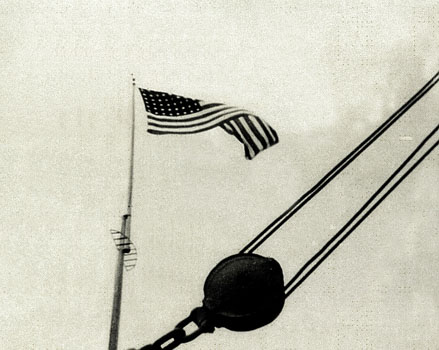 |
 |
| 18. The Original Sheet Music of the
Official US Coast Guard Theme Song, "Semper Paratus." (Sam
Fox Music Publishing, Cleveland, Ohio) |
19. Old Glory waving proudly up in the rigging. For the American men and women of
World War II the Stars and Stripes symbolized everything they were
sacrificing and fighting for. (Freiermuth family) |
20. Since basic training the men of the Pequot were galvanized by
this song into the spirit and camaraderie of their Coast Guard
service. (Semper Paratus Lyrics
by
Captain Francis Saltus Van Boskerck USCG, 1927) |
 |
 |
 |
| 21. (Office of War Information 1943) |
22. World War II Era Coast Guard
Patch. In the best tradition of the service's Latin Motto Semper
Paratus the Pequot crew was "Always Ready". (Calamaio family) |
23. (Government Printing Office) |
| "United States Coast Guard - Its Purpose and Activities in War and Peace" | |||
 |
 |
 |
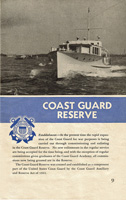 |
|
|||
THE
PEQUOT'S WORLD WAR II HOME PORT
In the image below we can spot the large warehouse with its distinctive
raised center roof on the wharf were Pequot was tied up when in
port (see photo #30 below). Located in Boston's historic North End
this area of piers and docks, which became the Coast Guard base, is
known as Constitution Wharf, since this was where the USS Constitution "Old Ironsides" was built and launched in 1797.

24. The US Coast Guard base which was Pequot's home port during WWII
was directly across the inner harbor from the Boston Navy Yard. In
this aerial photo from May of 1945 we can see the USS
Constitution berthed in the foreground. |
24B. To protect Boston Harbor the Pequot laid four indicator loops in a defensive semi-circle stretching more than 17 miles. This was the initial defensive perimeter for the entire Boston area. Two loops were operated from the Nahant Peninsula and two from Strawberry Point in North Scituate. Click the Image above to Enlarge (and click again to enlarge further) to see the wide range of underwater defenses put in place to protect this strategically important port. It is clear when looking at these loop installations the high level of skill and expertise needed by the Pequot skipper and crew to install those cables over such vast distances while maintaining the proper spacing between the three legs of each detection loop. This would be challenging and require expert seamanship even today with the use of GPS navigation. These loops were installed early in the war when U-boat attacks were at their peak. The Pequot was very vulnerable sitting off-shore going about the slow moving and methodical tasks involved in putting down these cables. Luckily the Germans didn't know what they were up to. (National Archives and Records Administration, Boston) |
George Simmons - Pequot Photographer
|
|
|
|
25. George G. Simmons Pequot Quartermaster & Photographer |
A native of Rhode Island, George Simmons served as a Quartermaster on the Pequot from late 1942 to the spring of 1945. George's photographs appear throughout this website, most of them donated by other crew members or their families. In a 1988 letter to Chief Yeoman Jim Hudow George explained, "I was the guy that had the camera. Getting the materials to develop pictures during war time was difficult for civilians, but I had a friend back home, who enjoyed doing it. He felt he was helping the war effort somehow, and that's how I was able to get so many pictures made." George got married while he was still aboard ship on April 22, 1944. George and his wife Edna settled back in Warwick, Rhode Island and raised 6 children and had 16 grandchildren.
Roger "Guns" Calamaio's Photos
One of the crew members
aboard the Pequot during the war was Gunners Mate Roger Calamaio -
then about 22 years old. These are his photos supplied by his son
Chip who wrote, "My family thought Dad's habit of writing all over
photographs was very annoying. Now I'm so glad he did! It's enabled
us to identify so many Pequot sailors."
A short memorial page to Roger's life and Coast Guard career is at: Sailor Roger Calamaio.
 |
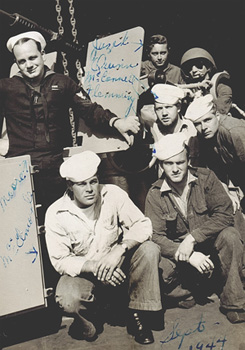 |
 |
| 26. Roger Calamaio aboard USCG Pequot in Boston Harbor - May 1944 | 27. Pequot Gun Crew, Boston Harbor - May 1944: Moore, McElmoyl, Jusek, Quin, McConnell, Fleming | 28. In Boston Harbor - May 1944: sailors Livingston, Cidoni and Simmons. |
|
|
29. In Boston Harbor - May 1944: sailors Cidoni, Jenkins and Livingston. |
30. Pequot in Boston Harbor - May 1944 |
 |
 |
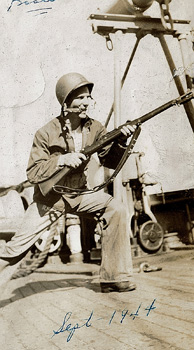 |
31. Sailor Jenkins - May '44, Boston Harbor |
32. Sailors McCormack and Cidoni practicing Hand-to-Hand, Boston Harbor, May 1944: |
33. Roger Calamaio - "ready for anything" - September '44 Boston |
 |
 |
 |
34. Sailors Coppo, Jenkins, Livingston, Cidoni and Carhart of the Pequot - May 1944 |
35. Crew on spar - May 1944: Sailors Cidoni, Jenkins, Coppo, Livingston, Fleming and Weber. |
36. Gun crew (L to R): Theodore Cline, Steven Cedoni on the 20mm deck gun, George Simmons, John McCormack. See note below about the Pequot's deck gun. |
The Pequot's Deck Guns
The Pequot's two fantail mounted deck guns were manually operated 20mm anti-aircraft weapons originally designed in Switzerland by the Oerlikon Corporation. It was mounted on a pedestal and could be trained through 360° and elevated from minus 5° to plus 87°. Considered a close range, high angle weapon, it was a recoiling, air cooled automatic AA gun which fired an explosive shell, including a "tracer" which glowed as it traveled towards its target and indicated the direction of fire. Manned generally by a three or four man crew it was capable of firing 450 rounds per minute, at 36° of elevation. Each magazine carried 60 rounds. Deck mounted ammunition lockers or "ready boxes" stored pre-loaded 20mm magazines and were located next to both gun positions for fast reloading. The 20mm AA gun had a maximum range of 5,500 yards.
The Irony
The historical irony is that the
Oerlikon Corporation almost went bankrupt in 1935 when the US Navy
rejected one of their guns in 1934 due to its low rate of fire.
However, the Japanese Navy's purchase of that weapon saved the Swiss
company, which allowed them further development work in conjunction
with the British, resulting in the more successful model used
extensively by the US military during WWII - and this 20mm auto-fire
cannon was based upon an original design for Oerlikon by Reinhold
Becker - a German!
|
37. 20mm anti-aircraft Oerlikon |
The Pequot Connection
The fascinating Pequot connection is that Steuart Mitchell (later
Sir Steuart), the son of Professor
Alexander Crichton Mitchell, the scientist who first invented the indicator
loop in WWI, is the one who sold Oerlikon's design to the US. In 1939 he
was the Inspector of Naval Ordnance, in charge of British Admiralty Ordnance
contracts in Switzerland, mostly at the Oerlikon works in Zurich. He quickly
made himself familiar with all aspects of the gun and made various improvements.
By June of 1940, when France fell and Italy entered the war, Oerlikons could no
longer be supplied from the Swiss, so Mitchell grabbed all the gun drawings and
parts he could lay his hands on and escaped, with the Nazis hot on his tail.
He went through the Balkans to Istanbul and finally down through Palestine to
Egypt, where he caught a plane back to London. Soon manufacture of the 20mm
began in England based on his Oerlikon drawings. In late 1940 Mitchell went to
the states and sold the gun to the Americans. It should be noted that Sir Charles Goodeve,
who also developed magnetic deperming techniques used on the Pequot and other allied ships to reduce the threat of sea mines, worked with Mitchell
on the manufacture of the Oerlikon in England. Through determination, cunning
and sheer trickery he was able to acquire some railway sheds and machine tools
to get an operational Oerlikon factory up and running in the town of Ruislip. His bulldog efforts had 20mms coming off the assembly line within 7 months, instead of the two years
originally projected by the complacent Admiralty. The rest is history.
| So the men of the Pequot were equipped to defend their indicator loop mission with a gun made possible by the son of the man who invented the indicator loops! |
 |
 |
38. Gun Crew - May 1944 |
39. 20mm Oerlikons during target practice aboard a Coast Guard Cutter off Block Island, Rhode Island April 18th 1944. (US Coast Guard Photo) |
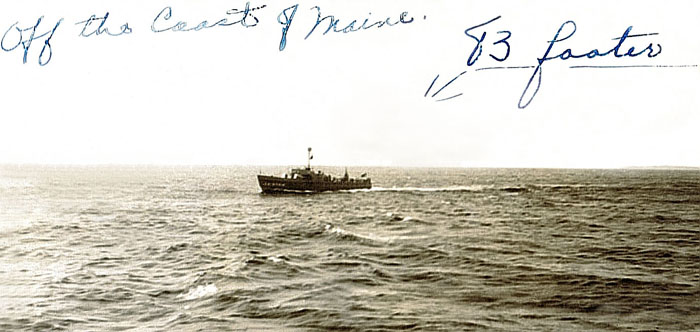 |
| 40. A Coast Guard "83 Footer" patrol boat protects
the Pequot off the shores of Maine in August of 1944. To see more about the 83 Footers and the many other types of ships that escorted and guarded the Pequot throughout the war Click Pequot's Escort Page. |
 |
 |
 |
41. Boston Harbor - May 1944. |
42. Sailors Livingston and Simmons - Boston Harbor - May 1944 |
43. Sailors McConnell, McElmoyl, Jenkins, Luongo, Campbell and Barnett on deck - Sept 1944 |
 |
| 44. Sailors Mike Luongo and Roger Calamaio - off the coast of Maine - August 1944. Notice the quick release lashing on the tarp next to them which covered the 20mm guns and protected them from the elements. In front of them we see two of the weather sealed ready-boxes which held the pre-loaded magazines for the deck guns. |
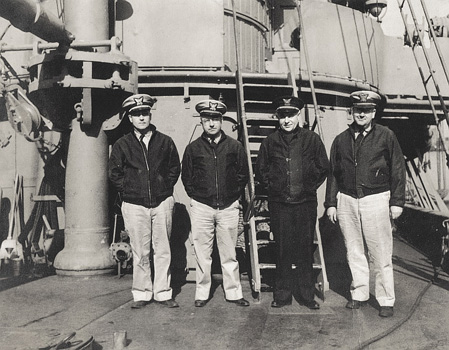 |
| 45. Officers of the USCG Pequot - March 1945 The Pequot's skipper during WWII was Captain Lars Anton Sande (2nd from the right). |
| The Scuttlebutt: According to Quartermaster Lou Carhart, the scuttlebutt among the Pequot crew was that Sande had served his entire Coast Guard career aboard the Pequot having first come aboard as a young seaman. That couldn't be further from the truth. We've learned from the skipper's son, Ted Sande, that his father had a very long and colorful career on a variety of Coast Guard and merchant ships. |
 |
 |
| 46, 47. Ted Sande, who was able to see his dad Lars Sande (shown above) several times during the war, actually stayed aboard the Pequot as a 10 year old boy. See our webpage "The Captain's Corner" for his recollections of life below decks during WWII, how his father chased Rum Runners during Prohibition, and the story of Sande's life at sea. (Ted Sande) | |
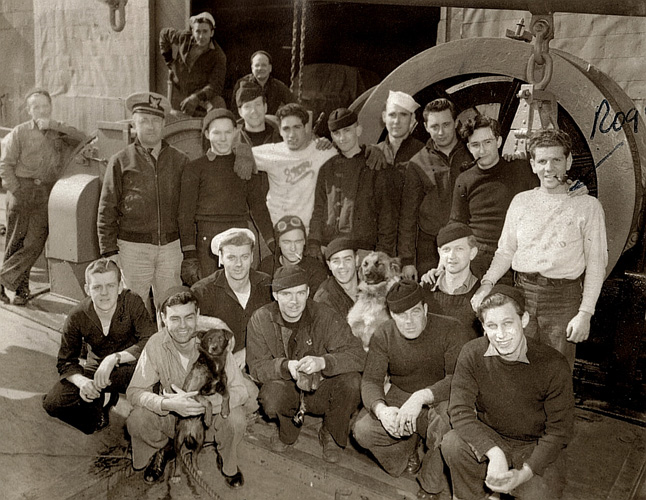 |
| 50. Officers, dogs and crew - March 1945. Click on photo to see names. |
 |
| 51. Crew on deck with officers
and dogs - March 1945. Seaman Mike Luongo tells us that the
dogs did go to sea with the Pequot's crew and that they weren't just
fair weather home port mascots. Click on photo to see names. |
 |
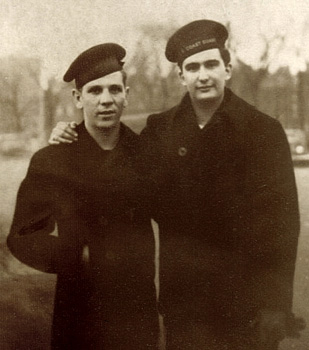 |
 |
| 52. Storekeeper 1st Class Bill Moore in front of a 20mm, September 1944. According to George Simmons, Moore conducted church services aboard the Pequot every Sunday morning. | 53.
Roger Calamaio and
Norman Zinner
ashore in their regulation Pea Coats 1943.
Roger loved that thick wool coat. He said it made him feel
"snug as a bug in a rug."
We believe that Roger and Norm
often ran errands together in the Boston area when the
Pequot was in port. |
54. As seen here in Buzzard's Bay, Massachusetts during 1943, right before Roger shipped aboard the Pequot he served as a Coast Guard jeep driver shuttling ship pilots along the Cape Cod Canal when convoys were forming up for the dangerous runs to Europe. |
|
 |
|
55. Roger in April 1943 on guard duty at the Coast Guard station at Buzzard's Bay, MA. |
56, 57. After their discharge
from the Coast Guard Roger Calamaio (right) and
friend had a train-station-booth photo taken in Detroit Michigan - in
Oct 1945 ... "and that is why they are so damned happy". Well, a
few beers may have helped. Note:
You can see the "ruptured duck" insignia on
his uniform that was given when sailors were discharged. |
|
| Many of the photos from Roger Calamaio's album were removed
and destroyed. His son sums up what is a rather poignant reminder of the lasting
effect of war: "There used to be other great pictures in that old photo album including some shots of the crew repairing and splicing cable, but it appears that after Alzheimer's started to take its toll, my Dad must have torn them all out. Perhaps what was going on in his befuddled mind was he thought it was all still Top Secret so he had to destroy those pictures. We will never know. There were two pages cut out of the album entirely. But I distinctly remember a number of pictures that were just not there any longer." Chip. |
 |
Radio Wars Click the image to the left to learn about the Radio Wars between allied ships and German U-boats. |
Communications Click the image to the right to see all the different ways Pequot could communicate without using radio transmissions. |
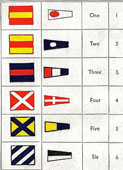 |
 |
Magnetic Deviation Click the image to the left to learn how the Pequot's compass binnacles had to be calibrated to account for magnetic deviations at different latitudes. |
Navigation Click the image to the right to see how the Pequot navigated the costal waters of New England in the 1940s without the aid of GPS or other satellite technologies. |
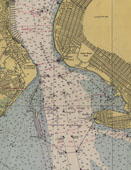 |
 |
Between The Wars Click the image to the left to learn about the Pequot's cable laying mission before WWII and all the trouble some worms could cause.
|
Magnetic Camouflage Click the image to the right to see how the ship was protected against German sea mines by a clever magnetic trick. |
 |
 |
The Battle of the Atlantic Click the image to the left to learn about the Pequot's home port of Boston, the Battle of the Atlantic, and what some dogs did.
|
The 1944 Hurricane Click the image to the right hear how the Pequot rode out a viscous hurricane that claimed 5 ships and the lives of hundreds of sailors.
|
 |
 |
60. Convoy ONS 154, seen
here steaming towards Europe, was a slow moving
northbound convoy of 45 ships which was attacked for
four days in December of 1942 by a 10 U-boat Wolfpack
resulting in the sinking of 16 ships, damage to another
10, and a great loss of life and vital war supplies.
This is just one example of the carnage wreaked upon
Allied shipping by U-boats in the early years of the
war, and it underscores the Pequot's vital U-boat
detection and harbor defense mission. |
OUR SAILOR'S STORIES
We've been able to learn more about many of the Pequot's WWII era crew.
A special thanks to the crewmen and family members who worked with us to honor
these men and helped develop their biographies. To see each sailor's story click on their photo.
 |
John J. McCormack - Radioman 1st Class
Growing up in New York State John was a Sea Scout as a boy and started tinkering with radios in high school. In addition to his war time service, being a Radioman became a life long hobby. To see the sailor's story click on their name or photo. |
Martin A. Coppo - Boatswain's Mate 1st Class Growing up in Northern Michigan with the chilly waters of Lake Superior as his swimming hole helped prepare Martin for his time on the Pequot. To see the sailor's story click on their name or photo. |
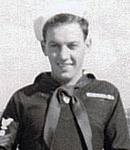 |
 |
Louis A. Carhart - Quartermaster 1st Class
Lou tells of his once in a lifetime experience when the Pequot escorted a captured German weather ship into Boston Harbor. To see the sailor's story click on their name or photo. |
Robert L. Livingston - Quartermaster 2nd Class The Pequot sailors Bob served with during the war held a special place in his heart and he kept in contact with many of them for years after VJ Day. To see the sailor's story click on their name or photo. |
 |
 |
Roger "Guns" Calamaio - Gunner's Mate 2nd Class Living off the land as a young boy in Oklahoma helped prepare Roger to
serve as Pequot's Gunner's Mate. Read what happened to this kid from
the Ozarks when he went to New York City by himself on his first liberty
after basic training. To see the sailor's story click on their name or photo. |
Clarke Straight - Chief Yeoman Before the war Clarke put himself through college and earned a business degree which made him a natural to serve as the Pequot's Yeoman. To see the sailor's story click on their name or photo. |
 |
 |
Michael Luongo - Seaman 1st Class When asked why he joined the Coast Guard during World War II instead of the Army or the Marines, Mike said "I figured why walk when you can ride!" To see the sailor's story click on their name or photo. |
Adolph H. "Ozzie" Frontel - Quartermaster In addition to his time on the Pequot in the North Atlantic Ozzie also served in the Pacific theatre and traveled as far as China. To see the sailor's story click on their name or photo. |
 |
 |
Paul Freiermuth - Seaman 1st Class Before shipping aboard the Pequot Paul "pounded the beaches" of wind swept Gloucester, Massachusetts on shore patrol which resulted in a hospitalization, an encounter with some MPs in Grand Central Station, and eventually his wedding. To see the sailor's story click on their name or photo. |
John J. Jusek - Seaman 1st Class When John Jusek went off to war he made a point of having a clarinet stashed in the bottom of his sea bag. To see the sailor's story click on their name or photo. |
 |
 |
Jim Hudlow - Chief Yeoman Jim served aboard the Pequot for 9 months and he tells us, that like most of his shipmates, had no idea the cable they were laying was part of a secret U-boat detection system. To see the sailor's story click on their name or photo. |
Norm M. Zinner - Yeoman 1st Class Except for what he might have picked-up aboard the Pequot, Norm had no
basic gunnery instruction and probably never fired a shot, since he didn't
even go through basic training after he enlisted and went on active duty. |
 |
 |
William Moore - Storekeeper 1st Class The industrious Bill Moore started his own business only two years after he graduated from high school, so when he signed up for the Coast Guard he already had many of the skills he needed to serve as the Pequot's top-notch Storekeeper. To see the sailor's story click on their name or photo. |
Stories in Development: Seaman Steve Cidoni, Steward Mate Lester H.Simmons, and Chief Machinist Roger W. Schaus Sr. |
| My Favorite Memory - Seaman Mike Luongo "We'd had some engine problems which were repaired in Norfolk, Virginia, so on Labor Day weekend in 1945 we were bringing the Pequot up to New York. Out at sea we had four hour watches where we had to do lots of things and pull different duty. As it turned out when we came into New York City I ended up on the helm in the wheelhouse. As we were coming in, I could start to see the New York skyline and I was told to put the bow right on the Statue of Liberty." Mike remembers. "That was the biggest thrill of my World War II years, being on the wheel and steering the Pequot into New York - straight at the Statue of Liberty." |
 |
|
(New York Harbor, Library of Congress) |
| Keeping 'em Fed! - Lester H.
Simmons - Pequot Stewards Mate
Pequot Stewards Mate Lester H. Simmons, along with Stewards Mate Clarence J. Carter, Ships Cooks Orris Weiss, Harris Sands, and Chief Commissary Steward Henry Hathway had the big job of providing all 63 members of the Pequot's crew with three meals a day and keeping the coffee pot in the crew mess hall brewing around the clock. Working together in the Pequot's small Galley they would bake and cook-up meals which Seaman Mike Luongo tells us were served "family style". Then they'd have to carry their hot chow along the outside gangways up forward and rear to the crew mess halls in the main deck cabin and up to the officer's rear staterooms on the upper deck. We can only imagine how tricky it must have been to carry those heavy trays and pots in the howling wind of the all too common North Atlantic storms on moving and pitching decks and metal stairs which were often wet and icy. And for the evening meal that often had to happen in in the dark when to avoid detection by U-boats all of the Pequot's lights were blacked out. According to his daughters Lester often told of how the galley crew would sneak off and raid the lobster pots laid by New England fisherman and serve up the Pequot officers and crew "The best meals in the Boston area!" Lester passed away in New York on August 24th 1997. |
 |
|
| The Weekend At York Beach
Click the Image to the Right to read the story of what happened when the Pequot took refuge and dropped anchor one weekend in the harbor at York Beach, Maine, as told by Pequot Quartermaster Lou Carhart and Seaman Mike Luongo. The crew's spontaneous antics surprised local residents and Carhart got to put his Morse Code training to practical use in a way never envisioned by his boot camp instructors.
|
 |
|
(Acclaro Inc.) |
| The Bachelor Party
Elaine Straight-Sanders shared a bit of family history with us involving her father Pequot Chief Yeoman Clarke Straight. "My Dad and Mom, Elsie, were to get married in December of 1943 at the Justice of the Peace Office in Boston. Well, my dad's shipmates took him out on sort of bachelor party the night before the wedding. I am assuming many beers were consumed as somehow a fight took place in the bar. The MP's were called and Dad, along with the others, were hauled off to the brig. The next day he didn't show up for the marriage ceremony leaving my Mom at the "altar!" Somehow things worked out and they finally did get married on January 9th 1944." |
 |
|
| (LoneSentry.com) |
| Ruined Whites
Pequot Gunners Mate Roger Calamaio used to tell the story of when he was "drunker than a hoot owl" on liberty in New York City and along with some of his Coast Guard pals found themselves in front of a club where the owner had sexy girls dancing up against the windows of the 2nd floor to entice customers into the place. Apparently he was quite enamoured by the sight of it all and spent a great deal of time slipping and sliding about off the sidewalk onto the sloping front lawn of the place. He admitted that, "I was pretty much laying there full front looking up and ogling those girls." When he got himself pulled together and back to the Pequot he discovered that the knees, elbows, and front of his white uniform was completely ruined and covered in bright green grass stains. |
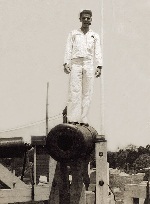 |
|
| Roger in his whites at Fort Phoenix Massachusetts May 1944 |
|
|
< |
Lou contributed greatly to the Pequot website project and spent many hours with researcher Chip Calamaio. "Lou was the very first person to contact me back in 2009 when we started searching for crew members. We spent a lot of time on the phone and even got together twice in Phoenix. Many of the details about life aboard the Pequot which are presented throughout the website came from Lou and he donated some wonderful photos of cable operations. It was also a lot of fun to talk to somebody who knew my Dad back when he was 20 years old." We have updated Lou's Biography based on material from our most recent conversations with him. |
Lou Carhart and Chip Calamaio - |
|

The Pequot - Other Duties
AS ASSIGNED
During the first year of the war when all resources were stretched to the limit, Coast Guard commanders had to use every asset at their disposal to solve logistical problems, and the Pequot was no exception. In June of 1941 while laying loop cable near Norfolk Virginia the Pequot received orders to distribute depth charges to Coast Guard cutters who were actively engaged in convoy escort duty and battles against U-boats.
The Commander of the Norfolk
District ordered Pequot to:
|
Proceed to Boston Massachusetts, via the Naval Mine
Dept, Yorktown, Virginia. Obtain 4 Y-gun depth charges for delivery to the Icarus at Stapleton, 3.I. N.Y., 6 Y-gun depth charges and 10 release track depth
charges for delivery to the Algonquin at Boston, Massachusetts, from the Naval
Mine Depot. This office will obtain and deliver 18 Y-gun propellant charges from
the Naval Ammunition Depot, St. Juliens Creek, Portsmouth, Virginia, to the Pequot prior to her departure for Boston, also for delivery to the Algonquin. |
 |
 |
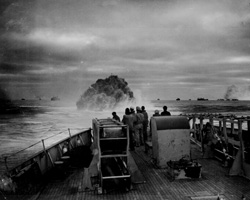 |
| 61. British sailors loading a Mk VII depth charge on to a Mk IV depth charge thrower with a block and tackle, 14 August 1942. Depth charges of the era could hold as much as 600 pounds of high explosives. (Royal Navy, Imperial War Museum Collection) | 62. USCGC Icaraus (WPC-110) in Charleston Navy Yard May 10th 1942 unloading German prisoners from the U- 352 which she had just sunk off the coast of Florida. (US Navy Photo) | 63. Coast Guardsmen on the deck of the cutter Spencer (WPG-36) watch the explosion of a depth charge during the attack which sunk the U-175 on April 17, 1943. (US Coast Guard, Photo #1517 by Jack January) |
 |
 |
 |
| 64. USCGC Algonquin (WPG-75)
provided escort duty to numerous North Atlantic convoys and distinguished herself
by picking up survivors from torpedoed ships in rough seas while placing herself
in danger. (US Coast Guard 1943 Photo #4287) |
65.
Y-Gun Depth charges were a WWI technology. They were shot into the
air from both sides of a ship to propel them away from the launching
ship to lay down a "pattern" of underwater explosions. (U.S. Naval Historical Center) |
66. A
release rack depth charge exploding behind a Coast Guard cutter
hunting U-boats. These charges were rolled off the stern or side of
a cutter by gravity and exploded at a pre-determined depth. (Life 1941) |
| |
Next Time Call Somebody Else! Pequot Gunner's Mate Roger Calamaio told of one harrowing experience he had with a depth charge. "We were in port and since I was a Gunners Mate I was called over to deal with a problem on a patrol boat tied up nearby. The protective cap had come off the end of one of their depth charges and they were worried. When I opened it up I saw that the bladder had filled up with rain and sea water and the firing pin was less than ¼ inch from making contact. Well, everybody else cleared way the hell off that dock and there I was by my lonesome on my hands and knees. I carefully put a little piece of wood in front of the firing pin and very slowly got the firing mechanism out. I was sweating like a son-of-bitch and I told them next time to call somebody else!" |
Photos from the John J. McCormack Photo Album
|
|
80. Four Pequot Crewmembers in Port. During the 1940s the Coast Guard and crew referred to blue jeans as "dungarees". |
81. A group of Pequot crewmen around the ladder to the bridge. |
|
|
82. Nine Pequot sailors with an unidentified officer. |
83. Three Pequot sailors with a cat from the Boston docks that tried to stowaway. |
PEQUOT AND CABLE LAYING - PHOTOS FROM LOU CARHART
The indicator loop 'tail' cable was towed from the shore by the Pequot crew using a DUKW
amphibious vehicle. The DUKW (popularly pronounced "duck") is a
six-wheel-drive truck that was designed by General Motors Corporation during
World War II for transporting goods and troops over land and water and for
use approaching and crossing beaches in amphibious attacks. There are some
good DUKW websites, and the USCG has two:
the Ira Lewis Scrapbook is a good one; so to is the factsheet from the USCG Military History website.
The loop 'tail'
cable was very heavy - weighing something like 3 tons per mile in air.
The photos of the Pequot crew in the DUKW were taken during cable laying at
the Peaks Hill Bar at the northern tip of
Cape Cod near Provincetown, Mass.
|
|
|
|
Additional Photos
from LOU CARHART
 |
 |
 |
| 98. Some of the Pequot crew on the main
mast rigging. Click on the photo to see an enlarged view with their names. Click again to enlarge more. |
99. Pequot crew members below decks in the engine room. The below decks crew was called "The Black Gang" by the other sailors because of how dirty they got from shoveling coal into the Pequot's boilers. To the right we see the receiving "telegraph" which gave the crew engine speed and prop rotation directions from the Quartermaster in the wheel house | 100. Seaman 1st Class Lester Jenkins with the Pequot dogs. Sailor Mike Luongo said the black dog's name was Midnight but he couldn't remember the other dog's name. "The dogs would hang around the docks and one of the crew would bring them on board." |
Undersea Cables - Quartermaster Lou Carhart tells us that Captain Sande had an amazing knack for finding undersea cables. "If we had to bring up a cable for salvage or repair he knew just where to drag the grappling hook. He'd snag it every time on the very first try." Lou explained that often during cable laying operations other Coast Guard electricians, who were not part of the permanent crew, would come aboard the Pequot, especially for cable repair work which he said could take several hours per splice. Mike Luongo added that, "Seaman Sullivan and O'Keefe did all the splicing. They were two Irish electricians from Boston." |
Mike Luongo's PHOTOS
Mike provided many of the images seen throughout this website and has helped us identify many of his shipmates.
 |
 |
 |
| 101. Through a hatch we see crew members with thousands of yards of indicator loop cable in the forward hold. | 102. Seaman Mike Luongo operating the Pequot's cable winch. | 103. Two seaman in the wooden launch during cable operations with the Pequot in the background. |
 |
 |
 |
| 104. The Pequot's deck was a very busy place during cable laying operations. | 105. From left to right three of the Pequot's Quartermasters up on the flying bridge; Frontel, Simmons & Livingston. Simmons is taking a bearing with a sextant. Note the deck compass in the foreground. | 106. A Pequot sailor up front with the cable winch gear. |
 |
 |
| 107. During cable laying operations crewmembers in the ship's launch. The Pequot is in the background. | 108. The Pequot during cable operations. Note all the crew up front playing cable over the ship's bow pulley. (if you look at this full screen you can faintly see the cable coming off the wheel). Click image to enlarge. |
| That Dangerous Dangerous Smoke! Although the thick column of dense black coal smoke coming out of the Pequot's stack looks almost picturesque to us today, that was actually very dangerous at the time. U-boats could spot smoke like that from miles away, even well beyond the horizon. Older coal burning ships like the Pequot were at a disadvantage when trying to avoid detection. There were instances where smoke from a single aging transport revelled the location of a convoy of more than 50 ships. The U-boat which spotted the smoke would radio nearby submarines resulting a coordinated 8-12 submarine 'wolf pack' torpedo attack on the convoy, with the loss of many ships and hundreds of lives. So the Pequot's coal smoke and slow moving, at times stationary, cable laying and repair mission made her extremely vulnerable. |
| "A Blanket of Soot" Ted Sande, son of Pequot Captain Lars A. Sande tells us, "One story Dad did relate, with some amusement, was that the Pequot was getting underway at Portland, Maine, probably in 1943, when there was a large force from the Atlantic Fleet anchored in the harbor with a lot of flag rank officers meeting. As she was steaming out, someone had failed to dampen the smoke from the coal burning boilers and Pequot laid down a blanket of soot on the flagship's deck, which resulted in a signal to my father that expressed the admiral's displeasure in no uncertain terms." |
 |
 |
| The US Navy saw coal smoke as a serious problem in both the Atlantic and Pacific. | 109. In the ship's launch a sailor with his hand firmly on the rudder looks back towards the Pequot to position the launch crew during cable operations. |
| "Working out in the launch could be
dangerous." Gunners Mate Roger Calamaio spoke of how hairy it was when they were "at a dead stop...like sitting ducks" while a small crew was out away from the Pequot doing cable work and the fear of U Boat attack wasn't the only risk. He said once a crew was out in the launch and a squall came up and the seas started to get really rough. Everyone aboard was watching the cable crew and they were worried that the launch was going to swamp as the storm blew in. That small boat was trying to go up and down with the waves but both ends of the heavy cable were holding it down and not allowing it to rise with the growing swells. He said it was "nip and tuck there for a while", but they finally got the repair finished and those guys back aboard before the storm really kicked in. "That was a close one," he said." |
 |
|
|
| 110. Two sailors in the launch shove off to set cable positions with round marker buoys. Note two of the Pequot's life rafts lashed up on the right. For details on how the crew placed buoys to mark the loop cable positions see Page 54 of the Harbor Defense Manual (in the next section). | 111. In 1944 the Pequot's seaman on deck during cable laying operations. Notice the indicator loop cable in the foreground being spooled out of the hold and up to the bow wheel. (McCormack family) |
112. A launch crew with an indicator loop marker buoy in 1944. We can see them retrieving the end of a cable that has been tied off on the buoy. (McCormack family) |
Installing many of the indicator loops involved very long cable runs. It appears that the Pequot's cable hold was enlarged early in the war and probably widened to increase the capacity of cable she could carry. The bump out seen here, which is directly in line with the forward hatch to the cable hold, is evidence of a modification to the Pequot's hull, since we do not see this protrusion in earlier images of the ship. Photos show this change on both the port and starboard sides. Even for a small ship the Pequot could carry a great deal of cable. In a Confidential Report dated October 23rd 1944 the Pequot's Captain Lars Sande writes of taking aboard "4,498 feet type 15-strand, 18-conductor submarine cable". The tail cable had a weight of 3 tons per mile in air, and the lead lined (or "lead loaded") loop cable itself - just over 6 tons per mile.
|
|
113. Modification to Pequot's hull. (Calamaio family) |
114. Boston Harbor 1944. (Calamaio family) |
USN Harbor Defense Manual - 1946
Published after WWII in 1946, The Harbor Defense Manual furnishes information about harbor defenses in the United States. During WW2 it became an instruction manual for Navy, Coast Guard and Army personnel given the responsibility of setting up and operating harbor defenses. After the war it was provided as general information to personnel not assigned permanently to the harbor defense work, and to capture the detailed technical knowledge obtained during the war years. It provides an overview of general harbor defenses (component training, planning, tactics, principles, teamwork and efficiency) and details the components in separate chapters: indicator loop, Herald (fixed sonar), and hydrophones; the role of the harbor control post; surface detection radar; patrol craft; smoke defenses; net and boom defenses; sneak craft, and passive defense. Below are excerpts from the manual that provide the technical principles, installation procedures, and the step-by-step process for laying indicator loops and how buoys were used to guide the positioning of cable laying (Pages 53-55). It also details the meticulous and time consuming step-by-step process for splicing various types of underwater cables (Pages 55-61). We must remember that Pequot's cable splicing work along the Eastern seaboard took place on bobbing and pitching decks, in small boats, and often in very foul weather. Many of the techniques perfected by the Pequot, and its crew during the war years, are captured in this manual.
Click on one of these page thumbnails to see an enlarged image of the page.
page 50 |
page 51 |
page 52 |
page 53 |
page 54 |
page 55 |
page 56 |
page 57 |
page 58 |
page 59 |
page 60 |
page 61 |
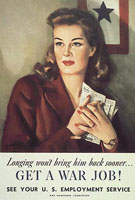 |
|
 |
MIKE LUONGO'S PHOTOS
Even though in many of these photos the crew is
obviously horsing around for the camera, the grim
reality was that the officers and men of the Pequot had
to be ready for a fight in case they ended up in a
surface battle with a U-boat and it's crew.
| Sleepless Nights. Pequot's Gunners Mate Roger Calamaio believed that was a very real possibility, "We thought that a U-boat might not want to waste a torpedo on us since we were so small, compared to the big cargo ships and tankers all around us, but they might surface and try to take us out with their deck gun and small arms fire. I had some sleepless nights about all of that when I first came aboard and would look down at that icy water. Once I realized there was no way I could change what might happen, I put myself in God's hands and slept like a baby." |
 |
 |
 |
| 115. Hand to hand combat with the Germans could have become a reality. | 116. Bob Livingston in port on a summer day having fun for the camera. | 117. Coxwain Robert McElymol with fixed bayonet and helmet up by the bow. |
| Standard Issue. In addition to Colt .45 caliber automatic pistols, the Pequot's small armory was stocked with Springfield M1903 .30 caliber bolt-action rifles. This World War I era gun with it's long 16-inch M1905 bayonet was standard issue in the Coast Guard during World War II and was the primary rifle available aboard ships and used by sailors during beach patrols. |
 |
 |
 |
| 118. Radioman John J. McCormack. | 119. Sailor Simmons is armed and ready. | 120. Sailor Lester Jenkins - Remember Sailor, pull that trigger just once and it'll cost you 50 bucks! |
| Hold Your Fire! The Pequot's officers didn't want crew members randomly discharging their weapons. Lou Carhart explains, 'Roger "Guns"Calamaio would checkout 45 caliber hand guns to the crew when they went on duty but they were warned not to fire. Unless it was an emergency it would cost you $50 for every bullet you fired. As our Gunner's Mate he would pick them up from us, exchange them, and keep them clean and loaded.' |
 |
121. A close-up from a 1945 photo shows two large steel munitions lockers with heavy duty watertight doors on both sides of the stairs to the bridge. We believe this is where small arms and ammunition was stored. In pre-war photos these lockers are not present, in many of our 1942-43 photos we see one locker, by 1944 two of these large steel cabinets are seen. |
 |
 |
 |
| 122. Two crewmembers below the bridge. Notice the .45 caliber side arm issued while on watch. | 123. Seaman 1st Class Steve Cidoni with rifle and helmet up by the bow. | 124. Lester Jenkins and another sailor in the wheelhouse. The navigation gyrocompass is seen in front of the helm and in the foreground we see the ship's main "telegraph"which gave the engine room crew directions on the Pequot's speed and propeller rotation - forward or reverse." |
 |
 |
| 125. An axe helps relieve the tension. Sailors Luongo, Cline & Livingston. | 126. Helmets on and smiles: Cidoni, Livingston & Luongo |
| Collision Drills - "We had collision drills so we were ready in case we got rammed or in case we hit another ship," Mike Luongo explains. "I was in charge of a big thick collision mat that was like a mattress. We'd have to practice quickly lashing it up against the hull with ropes to plug a hole in the ship." |
 |
 |
 |
| 127. In their GI Issue wool sweaters sailors Simmons, Jenkins and Frontle. | 128. Sailors Quinn, Cline & Livingston on work detail. | 129. Pequot Machinist Mate 1st class Anello J. Castaldi in his "undress blues." The hash mark on his sleeve indicates he already has served at least 4 years of active duty. |
 |
 |
| 150. Two Pequot Sailors in Port. | 151. With the Union Jack waving in the breeze up on the bow behind them we see Jusek, Benoit and their pals looking sharp in those dress blue uniforms for shore leave. |
| Evading the Shore Patrol - Pequot Storekeeper Bill Moore grew up around Salem, Massachusetts just North of Boston and knew the area well. According to his son Gary, "My Dad said that when he was on shore leave during the war the waterfront recreation opportunities were limited and subject to blackout conditions at night. He told us of covert passages up and down the Danvers River to spend time at Salem Willows Seaside Park with its restaurants, arcades, and other fun things to do. Apparently, with no gas available, it was easier to paddle down the river and risk being arrested by the shore patrol. Dad told of several evasive tacks he and my Mom, Mary, took to avoid being mistaken for infiltrating Germans!" | 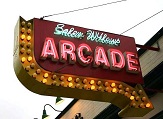 |
|
| Salem Willows Park (yelp.com/Holly S) |
 |
| 152. Machinist Mate Theodore Cline, Seaman Mike Luongo, and Quartermaster Livingston. |
PHOTOS FROM THE JOHN JUSEK FAMILY ALBUM
 |
 |
| 153. John Jusek (right) aboard the Pequot. | 154. John (right) ashore with some of his friends. |
 |
 |
| 155. John with his good friend Norman Zinner in the dory. | 156. Zinner and Jusek on shore leave. |
| Potato Vodka
Pequot Radioman John McCormack used to tell his son Mike how the Pequot galley crew would brew up some alcohol and home made hooch on the sly from potatoes and potato peelings. After a bit of research we've learned that was not an uncommon shipboard practice going back very deep into maritime history!
|
 |
|
| US sailors peeling potatoes 1942 (ipernity.com) |
|
|
157. John standing in the back while his pals clown around for the camera. |
158. Hitting the road on liberty - somebody had a car! |
MIKE LUONGO'S PHOTOS
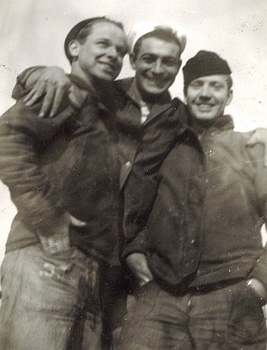 |
 |
| 159. The best of pals - Sailors Cline, Luongo and Quinn | 160. 14 crew members on
the Pequot's starboard side |
| Mess Hall - According to Seaman Mike Luongo there
were two crew mess halls on the Pequot during WWII.
"We ate in the forward mess hall and the Black Gang
ate in the one in the back. We really didn't socialize
too much with those guys, except when we were on
Liberty. The mess cooks would bring the food up from
the Galley on big trays and since there was not enough
seating for everybody we ate in three shifts by
seniority. The guys who were aboard the longest got to
eat first,"Mike remembers. "The food was very good
and we ate family style. The mess crew did a lot of
baking. They would make bread and pies. Hathaway made
good pies and hot crossed buns. There was coffee in
the mess 24 hours a day and that's where we'd sit and
write letters, play cribbage, and listen to the
government radio station. I remember listening to the
World Series,"Mike adds. What Mike and the other Pequot crew listened to were
most likely the Armed Forces Radio Service (AFRS)
broadcasts which the War Department's Armed Forces
Network launched on May 26th 1942 as a world-wide news
and entertainment network to improve troop morale and
give service members "a touch of home."Programming
included music, war news, and regular variety programs
including the popular "Mail Call,""Music Hall,"and
"Command Performance"which featured stars such as
Jack Benny, Bob Hope, Louis Armstrong, Red Skelton,
Bing Crosby and the Andrew Sisters. To listen to
samples of these vintage radio programs visit: Rand's Esoteric Old Time Radio |
 |
 |
 |
| V for Victory or "V DISCS"such as this one by the Andrew Sisters were produced by the government and major recording companies exclusively for American solders, sailors, and airmen serving overseas. "(University of Missouri, Miller Nichols Library, Kansas City) | Judy Garland,
Bing Crosby, and Jimmy Durrante recording a "Mail
Call"segment for the May 17th 1944 Command
Performance program. (AFRS photo) |
Music Hall program #108, December 28th, 1944. In addition to live transmissions, AFRS sent records of programs all over the world to all branches of the military. (rand's esoteric otr) |
 |
 |
| 163. Officers & crew up at the bow. Notice the buoys in the foreground that were used to mark loop cable positions. | 164. A sailor at the Coast Guard base sawing lumber for use on the Pequot. |
 |
 |
 |
| 165. Mike Luongo with intercom system. One of the Pequot's 20mm guns is under the tarp. | 166. Boatswain's Mate Charles Miller by the forward winch equipment. | 167. Sailor Mike Luongo has a 'Corn on the Cob' break on the Starboard Gunwale. |
 |
 |
 |
| 168. Sailor Luongo (right) and friends in port. | 169. For centuries sailors have passed time aboard ship making intricate rope weavings. Here George Simmons shows off his rope mat down in the crew quarters in 1944. Notice how tightly spaced the bunks are stacked behind him. With more than 60 men aboard space was at a premium. | 170. Seaman 1st Class Mike Luongo ashore |
 |
 |
| 171. With Livingston, Frontel and Luongo we see Lester Jenkins on duty and armed with a regulation 45 caliber sidearm. | 172. Sailor Hoganson - Maintenance work on the Pequot was hard dirty work. |
 |
 |
| 173. Sailor Hoganson by the forward winch gear. | 174. Pequot Sailors against the port gunwale off the coast of New England. |
SOME PHOTOS FROM THE JAMES H. HUDLOW ALBUM
 |
 |
| 180. L to R: William D. Brooks, Signalman 3rd Class, Seaman Lester Jenkins, Sailor 'Gillian' (perhaps Elmer Gillenwater), Quartermaster Ozzie Frontle, Storekeeper William Moore. | 181. Photo day in the launch on what looks like a cool windy day. |
 |
 |
| 182. Here it looks like Chief Commissary Steward Henry Hathaway is fishing from the launch. | 183. Seaman Roland Benoit catching a few winks during a break in the action. |
| The Bad Pie Chief Commissary Steward Henry Hathaway (seen above) was widely known by the Pequot crew for his excellent baked goods. His homemade pies especially got rave reviews. But somehow one day when the Pequot was in port at New York things just went wrong. On the morning of September 11th 1945 Gunners Mate Roger Calamaio found himself on a gurney heading for the OR in the US Marine Hospital on Staten Island. He'd come in during the middle of the night with terrible abdominal pains. "They were prepping me to take out my appendix,"Roger recalls. "As they were rolling me down the corridor a doctor ran up and asked, "What ship are you off of sailor?""The Pequot, Sir" |
|
|
"Did you have any of the lemon meringue pie last
night?" Roger must have been pretty sick since according to his USCG medical records he spent a full week in the hospital with "Acute Gastroenteritis"and wasn't discharged until September 18th. "That was really a close call,"he used to say, "because they were just about to cut me open!" |
||
|
|
|
184. Back (L to R): Steven Cidoni and Mike Luongo. Front: Paul Quinn and Bob Livingston. |
185. Sailors Bob Livingston (left) and Mike Luongo. |
186. Back row (L to R): Bob Livingston, Lester Jenkins and William D. Brooks, Signalman 3rd Class. Front: George Simmons, Adolph (Ozzie) Frontel. |
|
|
 |
| 187. From the top down: William D Brooks, Quartermasters Simmons, Frontel, Jenkins and Livingston below. | 188. In the wheelhouse Seaman Lester Jenkins looks on as Ozzie Frontel keeps a steady hand on the helm of the Pequot. |
189. Pequot sailor on the ladder while in port |
|
|
 |
190. Chief Machinist, Roger W. Schaus in his new uniform right after his promotion to warrant officer. Schaus supervised the engine room "black gang"below decks and kept all mechanical systems functioning. |
191. At Boston's Constitution Wharf two Pequot sailors - Clyde J. McFarland and Kenneth M. Dowling - in their dress blue uniforms getting ready for shore leave. |
192. James F.
Ryan Boatswain's Mate Mate 2nd Class, Boston, Massachusetts
1943. After the war Paul settled near Gary, Indiana. (Coppo
family). |
SOME MORE PHOTOS FROM THE LUONGO ALBUM
|
|
193. Mike Luongo ashore, armed and ready. |
194. Quartermaster Bob Livingston, Carpenter's Mate Wallace Hoganson, and Seaman Mike Luongo |
|
|
|
| 195. Mike Luongo with his friend, George Corrino, and another sailor, in a Portland Maine photo booth while the Pequot was in port. | 196, 197. Seaman Mike Luongo back home in
Belleville, New Jersey on liberty with some of his old friends
who were also serving their country. |
|
THEY WON
The following photos from Gunner's Mate Roger Calamaio's photo album were taken in October 1945. His son Chip gives this perspective...The war was over. The Pequot was out of harm's way. The ship and men were safely nestled in port at Staten Island, New York. They did it. They'd actually survived World War II. In these photos we see them goofing around and sense their elation and relief. It was suddenly a different world than the life they had been living with U-boats and the threat of death constantly around them. Now it wasn't fixed bayonets and gunnery practice, it was smiles, and hugs, and the ability to just be silly again. This was probably the last time they were all together - young boys from across America who came forward and quickly became men and became sailors. They put their lives on the line for America. Without realizing it they had just concluded the finest chapter of their generation.
They had served their country.
They were heroes.
Every one of them.
After all, they'd won the big one and they were all going home.
What a wonderful word.
Home.
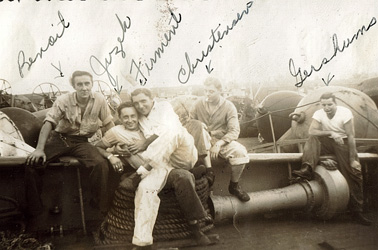 |
 |
| 202. | 203. |
 |
 |
| 204. | 205. |
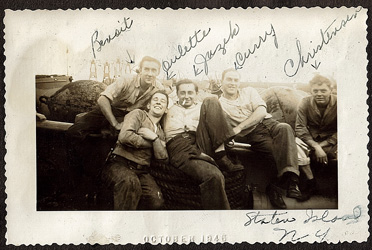 |
| 206. |
|
|
|
207. Sailors Joseph Davy, Leonard Elber, Clyde McFarland, Don McGrath, Fisher and Thornley - Staten Island - Oct 1945 |
208. Sailor Richard Christensen, Staten Island |
209. Sailor Alphonse Ouellette, Staten Island |
All the men who served aboard the Pequot were awarded the
World War II Campaign Ribbon for the American Theater of Operations.
|
|
|
210. Discharge buttons |
211. US Campaign Ribbon. (30th Infantry Division website) |
212. "Ruptured Duck" - awarded upon discharge |
Sailing List of Officers and Enlisted Men
Attached to USCG Pequot on February 6th 1945

As evidenced by the "(R)" next to most crew names below, during World War
II, the Coast Guard suspended regular enlistments and all of the
approximately 115,000 men and women who signed-up served as Reservists. That
figure includes 51,000 Temporary Reservists and 12,000 members of the
Women's Reserve, called The Spars. Because everyone who joined during the
war were Reservists, only 8% of the 214,000 Coast Guardsmen that served
during WWII were non-Reservists. At the end of hostilities most Reservists
were released to inactive duty or discharged. The Spars were disbanded in
July of 1947.
L. A. SANDE, Lieutenant BENJAMIN I. MIXON, Lieut.(j.g.) CARL E. JENKINS, Chief Boatswain |
JAMES A. SWEENEY, Chief Boatswain JAMES M. BROWN, Chief Boatswain WALTER W. BOND, Chief Machinist |
ADAMCZYK, Joseph J. F.1c. (R) APPLEBERRY, Evert.E. W.T. 2c.(R) BAKER, Arthur G. F.1c(MoMM) (R) BARNETT, Alonzo T. M.M. 3c. (R) BENNETT, William F. W.T.3c. (R) BENOIT, Roland A. Sea. 1c. (R) BROOKS, William D. S.M. 3c. BUCHHOLZER, David R. M.M. 2c. (R) CALAMAIO, Roger G.M. 2c. (R) CAMPBELL, Harry W. Sea. 1c. (R) CARHART, Louis A. Sea 1c. R) CARTER, Clarence J. St.M.3c(R) CASTALDI, Anello J. M.M. 1c(R) CHRISTENSEN, Richard R. Sea. 1c(R) CIDONI, Steven T. Sea. 1c.(R) CLINE, Theodore E. M.M. 3c.(R) COPPO, Martin A. B.M. 1c DAVY, Joseph A. F.1c.(R) DOWLING, Kenneth M. R.M.3c ELBER, Leonard Sea. 1c. (R) EVANS, Russell D. Sea. 1c. (R)
FREIERMUTH, Paul R. Sea. 1c. (R) FRONTLE [FRONTEL], Adolph H. Q.M. 3c. (R) GILLENWATER, Elmer D. Sea. 1c. (R) HATHAWAY, Henry M. C.C. Std. HATHAWAY, Robert H. C.M.M. JACHEC, Theodore J. C.M.M. |
JENKINS, Lester K. Sea. 1c. (R) JUSEK, John J. Sea. 1c. (R) KEEFE, Richard B. E.M. 1c(R) LISA, John D. F.1c (MoMM) (R) LIVINGSTON, Robert L. Q.M. 2c(R) LOWRY, Eldon L. F.1c. (R) LUONGO, Michael Sea. 1c(R) McCLELLAN, Clarence E. M.M.3c. (R) McCONNELL, Mervin O. Sea. 1c. (R) McCORMACK, John J. R.M. 1c. McELMOYL, Robert W. Cox. (R) McFARLAND, Clyde J. Sea. 1c. (R) McGRATH, Donald M. R.T. 3c. (R) MOORE, William S. S.K. 1c. (R) NELSON, Neil C. Sea. 1c. (R) OUELLETTE, Alphonse J. Sea.1c. (R) PALENSCAR, Arthur G. MoMM.1c. (R) POUNDS, Wilbert W. Ph.M. 2c. QUIN, Paul E. Sea. 1c. (R) ROBERTS, Isiah St. M. 2c. (R) RYAN, James F. B.M. 2c. (R) SANDS, Harris A. S.C. 3c. (R) SEALE, Leslie J. M.M. 2c. (R) SHERLOCK, William H. B.M. 2c(R) SIMMONS, George G. Q.M. 2c. SIMMONS, Lester H. St. 1c. (R) SULLIVAN, Patrick J. E.M.1c.(Tel)(R) WIESE, Orris S.C. 1c. ZINNER, Norman M. Y. 1c (R) |
Three additional last names were hand written on the bottom of the shipping
list, Pearce, Fisher, Campbell K.
It can be assumed they joined the crew after the Feb 6th [1945] list was typed up.
Paul Fleming's name was struck out in pen on the original, so he must have left
the crew around Feb 6th.
Pequot Crew Occupational Abbreviations
| B.M. | Boatswain's Mate | R.T. | Radio Technician |  |
|
| Cox. | Coxswain | S.C. | Ship's Cook | ||
| E.M. | Electrician's Mate | Sea. | Seaman | ||
| F. | Fireman | S.K. | Storekeeper | ||
| G.M. | Gunner's Mate | S.M. | Signalman | ||
| MM | Machinist's Mate | St. M. | Steward's Mate | ||
| MoMM | Motor Machinst's Mate | W.T. | Water Tender | ||
| Ph M | Pharmacist's Mate | Y. | Yeoman | ||
| Q.M. | Quartermaster | 1c | 1st Class | ||
| (R) | US Coast Guard Reserve | 2c | 2nd Class | ||
| R.M | Radioman | 3c | 3rd Class | 213. Click image to enlarge |
See: http://www.history.navy.mil/books/OPNAV20-P1000/A.htm
Acknowledgements and Contributors
Pequot Crew Members |
| Louis A. Carhart- Pequot Quartermaster Jim H. Hudlow - Pequot Chief Yeoman Mike Luongo - Pequot Seaman Stephan T. Cidoni Sr. - Pequot Seaman |
| Family Members |
Lee Coppo - Wife of Boatswain's Mate Martin A. Coppo |
| Contributors and Research Assistance |
Dr
Richard Walding - Griffith University, Brisbane, Australia |
A special thanks to Linda Walding and Carolyn Barbier for the support and encouragement. |
Web hosting courtesy of
Ben Walding
| Bibliography |
The Blue Jackets' Manual United States Navy, 11th Edition 1940. United States Naval Institute, Annapolis, Maryland Coast Guard Version of Bluejackets' Manual 1940, Chapters 18 to 22 United States Coast Guard, October 20, 1943 The U.S. Coast Guard in World War II, Malcolm E. Willoughby Naval Institute Press, Annapolis, Maryland 1957 Bloodstained Sea, The U.S.Coast Guard in the Battle of the Atlantic, 1941-1944 Michael G. Walling, International Marine / McGraw-Hill 2005 Prints In The Sand, The U.S. Coast Guard Beach Patrol During World War II Eleanor C. Bishop. Pictorial Histories Publishing Co. 1989 The Story of the U.S. Coast Guard, Eugene Rachlis Landmark Books / Random House 1961 Smartest Ship Afloat!, Bill Reiche Popular Mechanics Magazine April 1947 The United States Coast Guard - A Pictorial History Gene Gurney, Crown Publishers, New York 1973 Splinter Fleet, Theodore R. Treadwell Naval Institute Press, Annapolis, Maryland 2000 The Military History of Boston's Harbor Islands, Gerald Butler Arcadia Publishing, Charleston, South Carolina 2000 Inventory of Historic Light Stations 1994 US Department of the Interior, National Park Service Nautical Rules of the Road, US Coast Guard United States Government Printing Office 1943 Annual Reports of the War Department for the Fiscal Year Ended June 30,1906 Volume IV Government Printing Office 1906 United
States Coast Guard - Its Purpose and Activities in War
and Peace The Arma Gyro Compass, Simplex
Equipment MK. 7 MOD. 4 The Sperry Gyro Compass, Mark XIV
Mod.1, Instructions 17-1400 D Introduction to Radio Equipment, Navy
Training Course, NAVPERS 10172 Catalogue of Naval Electronic
Equipment - NavShips 900,116 US Navy Visual Call Sign Book, DNC 4
(A) Ships of the United States Navy and
Their Sponsors The Ships and Aircraft of the United
States Fleet, James C. Fahey U.S Army Ships and Watercraft of World
War II, David H. Grover U.S. Coast Guard Cutters and Craft of
World War II, Robert L. Scheina Warships of the Civil War Navies, Paul
Silverstone Allied Escort Ships of World War II,
Peter Elliot Building the Navy's Bases in World War II The United States Coast Guard in World
War II, Thomas P. Ostrom The Men All Singing, The Story of
Menhaden Fishing, John Frye Target Pearl Harbor by Michael
Slackman Legend of The "Torpedo Gang" Japanese Eyes, American Heart:
Personal Reflections of Hawaii's World War II Nisei. A Careless Word...A Needless Sinking Outfield Fly: By Hap Rocketto Air &
Space Magazine August/September 1993 The U.S. Army on Kaua'i,
1909 - 1942 History of Communications - Electronics in the United States Navy Regulations Governing the Uniforms for Commissioned and Warrant Officers and Enlisted Men of the United States Coast Guard. US Government Printing Office 1930
|
Every effort has been made to trace and acknowledge copyright. The authors would welcome any information from people who believe their photos have been used without due credit. Some photos have been retouched to remove imperfections but otherwise they are true to the original.
If you have any further details of USN
harbor defences
or antisubmarine harbor defences in general (Indicator Loops and Harbour
Defence Asdic) that may help with this research project please email me [Richard Walding] at the
address at the top of the page.
LINKS TO RELATED PAGES:
Indicator Loops around the World (Home Page)
How an indicator loop works
United States Navy Loop Receiving Stations


